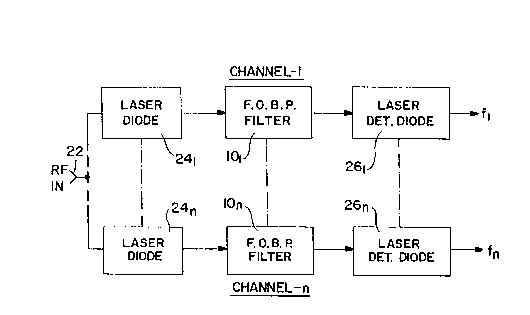Une partie des informations de ce site Web a été fournie par des sources externes. Le gouvernement du Canada n'assume aucune responsabilité concernant la précision, l'actualité ou la fiabilité des informations fournies par les sources externes. Les utilisateurs qui désirent employer cette information devraient consulter directement la source des informations. Le contenu fourni par les sources externes n'est pas assujetti aux exigences sur les langues officielles, la protection des renseignements personnels et l'accessibilité.
L'apparition de différences dans le texte et l'image des Revendications et de l'Abrégé dépend du moment auquel le document est publié. Les textes des Revendications et de l'Abrégé sont affichés :
| (12) Brevet: | (11) CA 2059587 |
|---|---|
| (54) Titre français: | CANALISEUR A FIBRES OPTIQUES POUR SIGNAUX RF |
| (54) Titre anglais: | FIBER OPTIC RF SIGNAL CHANNELIZER |
| Statut: | Périmé et au-delà du délai pour l’annulation |
| (51) Classification internationale des brevets (CIB): |
|
|---|---|
| (72) Inventeurs : |
|
| (73) Titulaires : |
|
| (71) Demandeurs : |
|
| (74) Agent: | KALEVI P. ASPILAASPILA, KALEVI P. |
| (74) Co-agent: | |
| (45) Délivré: | 1999-09-07 |
| (22) Date de dépôt: | 1992-01-17 |
| (41) Mise à la disponibilité du public: | 1992-08-20 |
| Requête d'examen: | 1994-02-02 |
| Licence disponible: | S.O. |
| Cédé au domaine public: | S.O. |
| (25) Langue des documents déposés: | Anglais |
| Traité de coopération en matière de brevets (PCT): | Non |
|---|
| (30) Données de priorité de la demande: | ||||||
|---|---|---|---|---|---|---|
|
An array of fiber optic RF filters each responsive to a
predetermined wavelength forms a channelizer for a wide bandwidth
receiver used in a dense signal environment having complex
modulations. Each fiber optic RF filter comprises a resonant
cavity formed from a section of multimode optic fiber with a
dielectric mirror deposited at each end and wherein the cavity
length corresponds to one half the respective modulation signal
wavelength of optical energy fed into the filter optic cavity from
a laser diode which is modulated by the received RF energy.
Note : Les revendications sont présentées dans la langue officielle dans laquelle elles ont été soumises.
Note : Les descriptions sont présentées dans la langue officielle dans laquelle elles ont été soumises.

2024-08-01 : Dans le cadre de la transition vers les Brevets de nouvelle génération (BNG), la base de données sur les brevets canadiens (BDBC) contient désormais un Historique d'événement plus détaillé, qui reproduit le Journal des événements de notre nouvelle solution interne.
Veuillez noter que les événements débutant par « Inactive : » se réfèrent à des événements qui ne sont plus utilisés dans notre nouvelle solution interne.
Pour une meilleure compréhension de l'état de la demande ou brevet qui figure sur cette page, la rubrique Mise en garde , et les descriptions de Brevet , Historique d'événement , Taxes périodiques et Historique des paiements devraient être consultées.
| Description | Date |
|---|---|
| Inactive : CIB expirée | 2013-01-01 |
| Inactive : CIB de MCD | 2006-03-11 |
| Inactive : CIB de MCD | 2006-03-11 |
| Le délai pour l'annulation est expiré | 2001-01-17 |
| Lettre envoyée | 2000-01-17 |
| Accordé par délivrance | 1999-09-07 |
| Inactive : Page couverture publiée | 1999-09-06 |
| Préoctroi | 1999-05-31 |
| Inactive : Taxe finale reçue | 1999-05-31 |
| Lettre envoyée | 1999-05-14 |
| Un avis d'acceptation est envoyé | 1999-05-14 |
| Un avis d'acceptation est envoyé | 1999-05-14 |
| Inactive : Dem. traitée sur TS dès date d'ent. journal | 1999-05-10 |
| Inactive : Renseign. sur l'état - Complets dès date d'ent. journ. | 1999-05-10 |
| Inactive : CIB attribuée | 1999-04-15 |
| Inactive : Approuvée aux fins d'acceptation (AFA) | 1999-04-13 |
| Exigences pour une requête d'examen - jugée conforme | 1994-02-02 |
| Toutes les exigences pour l'examen - jugée conforme | 1994-02-02 |
| Demande publiée (accessible au public) | 1992-08-20 |
Il n'y a pas d'historique d'abandonnement
Le dernier paiement a été reçu le 1998-11-28
Avis : Si le paiement en totalité n'a pas été reçu au plus tard à la date indiquée, une taxe supplémentaire peut être imposée, soit une des taxes suivantes :
Veuillez vous référer à la page web des taxes sur les brevets de l'OPIC pour voir tous les montants actuels des taxes.
| Type de taxes | Anniversaire | Échéance | Date payée |
|---|---|---|---|
| TM (demande, 6e anniv.) - générale | 06 | 1998-01-20 | 1997-10-21 |
| TM (demande, 7e anniv.) - générale | 07 | 1999-01-18 | 1998-11-28 |
| Taxe finale - générale | 1999-05-31 |
Les titulaires actuels et antérieures au dossier sont affichés en ordre alphabétique.
| Titulaires actuels au dossier |
|---|
| GOVERNMENT OF THE UNITED STATES, AS REPRESENTED BY THE SECRETARY OF THE ARMY (THE) |
| Titulaires antérieures au dossier |
|---|
| CHARLES E. KONIG |